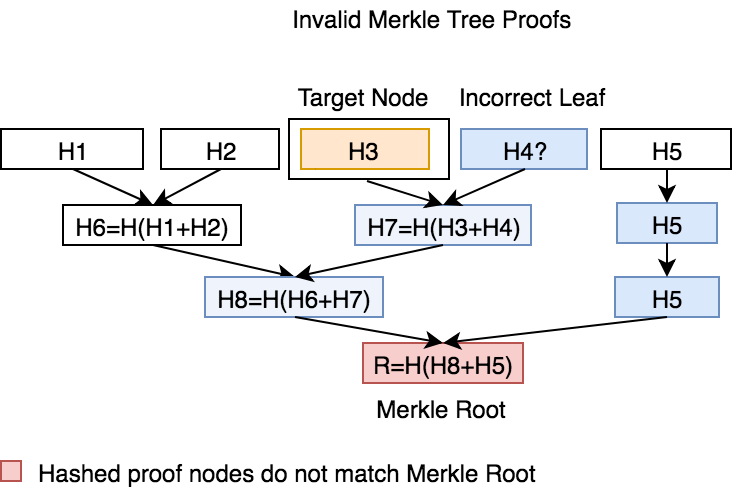|
|
||
|---|---|---|
| .github | ||
| diagrams | ||
| docs | ||
| example | ||
| src | ||
| test | ||
| .editorconfig | ||
| .eslintrc | ||
| .gitattributes | ||
| .gitignore | ||
| .node-version | ||
| .npmignore | ||
| .npmrc | ||
| .travis.yml | ||
| LICENSE | ||
| README.md | ||
| package.json | ||
| tsconfig.json | ||
README.md
MerkleTree.js
Construct Merkle Trees and verify proofs in JavaScript.
Contents
- Install
- Example
- Getting started
- Diagrams
- Documentation
- Test
- FAQ
- Notes
- Resources
- Contributing
- Tip Jar
- License
Install
From NPM:
npm install merkletreejs
CDN
Available on jsDelivr CDN:
<script src="https://cdn.jsdelivr.net/npm/merkletreejs@latest/merkletree.js"></script>
Example
https://lab.miguelmota.com/merkletreejs
Getting started
Construct tree, generate proof, and verify proof:
const { MerkleTree } = require('merkletreejs')
const SHA256 = require('crypto-js/sha256')
const leaves = ['a', 'b', 'c'].map(x => SHA256(x))
const tree = new MerkleTree(leaves, SHA256)
const root = tree.getRoot().toString('hex')
const leaf = SHA256('a')
const proof = tree.getProof(leaf)
console.log(tree.verify(proof, leaf, root)) // true
const badLeaves = ['a', 'x', 'c'].map(x => SHA256(x))
const badTree = new MerkleTree(badLeaves, SHA256)
const badLeaf = SHA256('x')
const badProof = tree.getProof(badLeaf)
console.log(tree.verify(badProof, leaf, root)) // false
Print tree to console:
console.log(tree.toString())
Output:
└─ 7075152d03a5cd92104887b476862778ec0c87be5c2fa1c0a90f87c49fad6eff
├─ e5a01fee14e0ed5c48714f22180f25ad8365b53f9779f79dc4a3d7e93963f94a
│ ├─ ca978112ca1bbdcafac231b39a23dc4da786eff8147c4e72b9807785afee48bb
│ └─ 3e23e8160039594a33894f6564e1b1348bbd7a0088d42c4acb73eeaed59c009d
└─ 2e7d2c03a9507ae265ecf5b5356885a53393a2029d241394997265a1a25aefc6
└─ 2e7d2c03a9507ae265ecf5b5356885a53393a2029d241394997265a1a25aefc6
Diagrams
▾ Visualization of Merkle Tree

▾ Visualization of Merkle Tree Proof

▾ Visualization of Invalid Merkle Tree Proofs

▾ Visualization of Bitcoin Merkle Tree

Documentation
See documentation (under docs/)
Test
npm test
FAQ
-
Q: How do you verify merkle proofs in Solidity?
- A: Check out the example repo merkletreejs-solidity on how to generate merkle proofs with this library and verify them in Solidity.
-
Q: How do you verify merkle multiproofs in Solidity?
- A: Check out the example repo merkletreejs-multiproof-solidity on how to generate merkle multiproofs with this library and verify them in Solidity.
-
Q: Is there an NFT whitelist example in Solidity?
- A: Check out the example repo merkletreejs-nft-whitelist on how to generate merkle root of whitelisted accounts and merkle proofs with this library and verify them in Solidity.
-
Q: Is there a CLI version of this library?
- Yes, see merkletreejs-cli.
Notes
As is, this implemenation is vulnerable to a second pre-image attack. Use a difference hashing function for leaves and nodes, so that H(x) != H'(x).
Also, as is, this implementation is vulnerable to a forgery attack for an unbalanced tree, where the last leaf node can be duplicated to create an artificial balanced tree, resulting in the same Merkle root hash. Do not accept unbalanced tree to prevent this.
More info here.
Resources
-
Bitcoin mining the hard way: the algorithms, protocols, and bytes
-
Why aren't Solidity sha3 hashes not matching what other sha3 libraries produce?
-
What is the purpose of using different hash functions for the leaves and internals of a hash tree?
Contributing
Pull requests are welcome!
For contributions please create a new branch and submit a pull request for review.
Many thanks to all the contributors that made this library better.
Tip Jar

3KdMW53vUMLPEC33xhHAUx4EFtvmXQF8Kf

0x9ed3D6793a6b74d8c9A998f5C4b50a25947D53aF
Thank you for tips! 🙏
License
Released under the MIT license.



